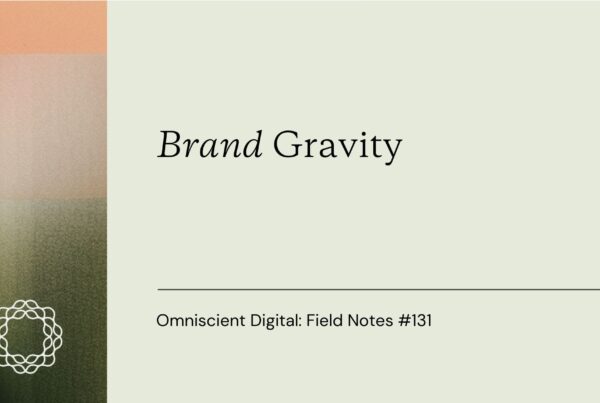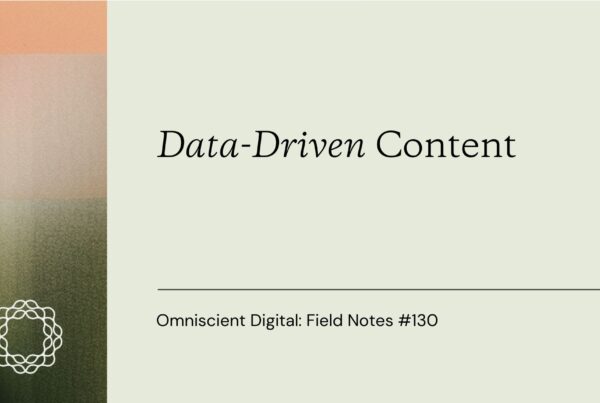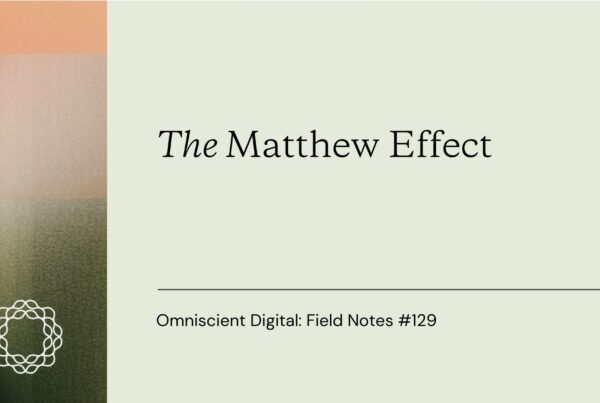
Assuming AI continues along its current trajectory, it will do several things to the economics of marketing and growing a business.
I’ll start with three presuppositions, and from those, I’ll talk about the New Gold, i.e. the dimensions of content I believe will hold the most value in a world of abundant and accessible information.
Three Possible Effects of AI in Marketing
AI is a force multiplier, right?
It’s a technological shift that is clearly removing bottlenecks that once constrained creativity, content, and commerce. Undoubtedly, this will increase the supply of these things, but the question that is of most importance is, how does that affect demand?
In domained-constrained economies, we often see a dilution of marginal value. However, that’s not always the case, as sometimes value is simply reallocated and innovation changes where and how value accrues.
To understand where differentiation will come from, we need to dissect the forces at play. AI’s impact can be broken down into three primary effects:
- AI democratizes production & increases supply.
- AI raises the floor for quality.
- AI reduces friction & increases accessibility.
These, in my opinion, are relatively safe bets, though by no means certain.
And because we’re dealing with micro-market dynamics (via platform, competitive, consumer, etc.), these forces will create second and third order effects that reshape what matters in marketing, SEO, and brand building.
Let’s start with the first: the democratization of content production.
1. AI Democratizes Production & Increases Supply
Very simply, AI makes it easier to produce “content,” and I mean content in the broadest sense. You know this is true simply by looking at your inbox, your LinkedIn comments, or your spam calls.
When you increase the supply of something in a market where demand is constrained or fixed (attention, by definition, has an upper limit for a single individual), a few predictable economic and behavioral effects occur.
Content, at its core, operates under the same fundamental laws as any other good—when production is no longer scarce, competition intensifies as the barrier to entry lowers.
The implications I could see playing out include:
- Decreased Marginal Value per Unit – If the volume of content increases while attention remains constant, each individual piece of content must fight harder to capture the same level of engagement. The average impact of any single blog post, video, or article diminishes.
- Greater Competition & Dilution of Quality – With fewer barriers to entry, more content floods every space. This creates “content dilution,” where high-value insights risk getting buried beneath a sea of generic material.
- Algorithmic & Gatekeeper Intervention – Platforms that distribute content (Google, LinkedIn, X, YouTube, AI-driven search) will need to lean even more heavily on filtering mechanisms, identifying hard-to-fake signals for trust, utility, and relevancy.
- Winner-Takes-Most Dynamics – In a market of nearly infinite supply and finite attention, the top 1%—those with strong brands, established audiences, or distinctive voices—capture outsized value. The middle tier suffers, and undifferentiated players struggle to gain traction.
- Attention Inflation & Content Fatigue – As people are bombarded with more content, expectations rise. What was once “good enough” is now ignored. Audiences become more selective, disengage entirely, or consolidate their attention to a few trusted sources.
The path forward for brands isn’t likely to be more content, at least content that is median quality and undifferentiated.
Now, one could take this first point and extrapolate that content’s value, in aggregate, diminishes.
However, I don’t believe that is the case, as deflationary technology that lowers friction tends also to increase the demand for higher quality versions of those assets (like how Starbucks seemingly unlocked an appetite for a greater variety of speciality coffees).
So, I think that the democratization of median level content production means that the floor is now raised for quality, which may lead to greater demand for differentiated content and experiences.
2. AI Raises the Floor for Quality
If AI-driven content production were just increasing supply, it would already be a disruptive force. But it does more than that—it raises the baseline expectation for what constitutes “acceptable” quality.
Historically, content creation has been constrained by two key factors: skill and time. Writing a coherent, well-researched article took effort. Designing engaging visuals required expertise. Crafting persuasive messaging demanded experience. These constraints served as natural barriers, creating a spectrum of quality in the market.
But when AI can generate structured, logically coherent, and SEO-optimized content in seconds, the lower and lower-middle rungs of that spectrum collapse. What was once considered “good enough” is now table stakes.
This has immediate consequences:
- The median content experience improves. Readers, users, and buyers are now accustomed to AI-assisted coherence. The bar for what is considered readable, well-structured, and information-rich has been permanently elevated. Anything below this new standard becomes invisible.
- Commoditization accelerates. If everyone can produce blog posts, listicles, and summaries at scale, differentiation no longer comes from executional competence—it comes from strategic depth, perspective, and originality.
- The value of generic information collapses. When AI can summarize and synthesize knowledge instantly, surface-level insights no longer hold intrinsic value.
If the above bits are true, then what I see happening is a shift from surface level information to value additive information in the form of proprietary data, firsthand experience, and original thinking. I can also see the value shifting from the content to the voice behind the content, the WHO rather than the WHAT as a fundamental trust signal. And I can also see us interweaving efficiency gains with a greater focus on creativity, and dare I say, the human power of irrationality, in creating a differentiated experience.
This is, by the way, GREAT for consumers and for brands that prioritize excellence. It’s bad for anyone relying on surface-level, easily replicable tactics.
3. AI Reduces Friction & Increases Accessibility
AI is a friction lowering machine from both a creation and consumption standpoint.
This is not something that came out of nowhere.
When wondering, over brunch with a friend, where what we know as “jazz” first originated, one may have simply had to continue on the rest of their life without knowing, unless they had the fortitude to remember to visit a library after brunch.
The internet pulled all of that information onto a screen. Google (and preceding search engines) helped sort and deliver that information. Featured snippets summarized it quickly.
Now, AI overviews are one step further into that future of seamless information gathering. Perplexity speeds up multi-source summarization. We’ll see new tools further decrease the friction to information access through multiple modality like video, audio, etc.
The effects are broad but follow predictable patterns:
- Speed & Efficiency Collapse the Traditional Content Lifecycle: The time required to do keyword research, create content briefs, run internal link audits, and do a ton of other table stakes activities condenses. This eliminates much of the manual labor previously involved in content creation.
- Retrieval Shifts from Search to Instant Synthesis: AI-powered search models (ChatGPT, Perplexity, Claude, DeepSeek) reduce the need for users to sift through multiple sources. Instead of clicking through search results, users receive direct, synthesized responses—compressing discovery into a single interaction.
- The Value of Raw Information Declines: When AI can instantly summarize research reports, extract financial insights, or condense books into bullet points, the competitive advantage of simply “knowing” something disappears. Access to knowledge is no longer the constraint—application, contextualization, and interpretation are.
- Aggregation & Middlemen Models Face Structural Erosion: Businesses built on information arbitrage—curation sites, research aggregators, traffic arbitrage content strategies—will find their value propositions weakened as AI automates summarization and retrieval. Some will adapt by offering exclusive or proprietary insights, but undifferentiated players will see diminishing returns (especially in terms of traffic).
- Attention Scarcity Becomes the Primary Bottleneck: As AI floods the ecosystem with more content, discovery mechanisms tighten, and audiences lean on trusted brands, authoritative sources, and human curation to filter the noise. The sheer availability of information does not equate to consumption—if everything is accessible, only the most trusted or compelling sources (or those best poised for distribution) win attention.
Alright, so with these three forces in play—production democratization, quality elevation, and friction reduction—the central question becomes: What actually stands out?
What Actually Stands Out?
Three things: credibility, novelty, and affinity.
These are the hard-to-fake signals that mattered before, and they matter even more now.
1. Credibility
The first filtering signal I’m indexing on is credibility. I’ve long written about this and adored the concept: the source of the information carries as much weight as the information itself.
I once heard Whitney Wolfe Herd say on Tim Ferriss’ podcast, “The most expensive currency in the world is experience.”
As in, I want to read a Paul Graham essay about building a startup, not a generic page from Zapier:
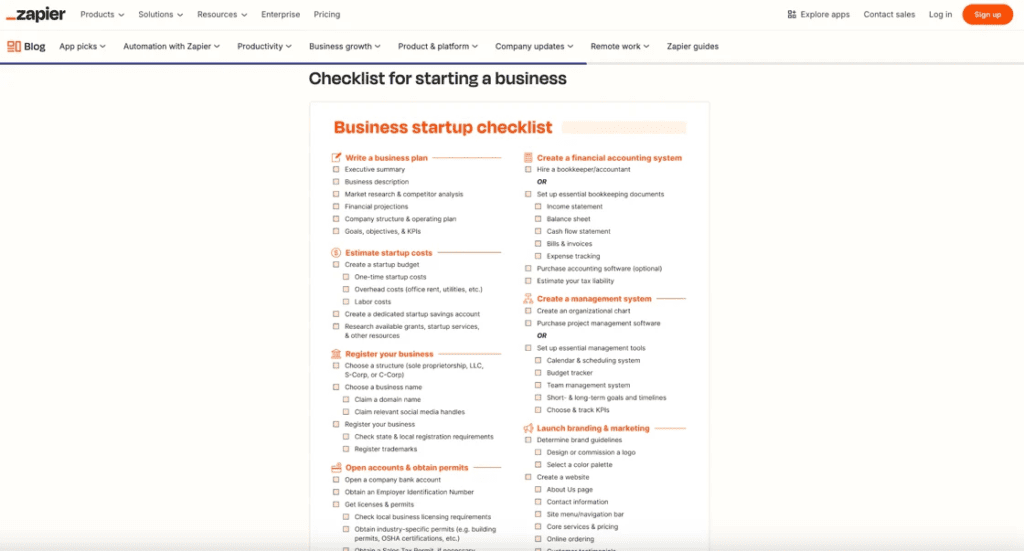
This is, at least in a theoretical sense, already in play with things like Google’s purported reliance on E-E-A-T signals. It’s also clearly the case with social media, where you see a name and a face pop up over and over again and you start to trust them and associate them with certain topics.
Founder-Led Brand & The Power of Visibility
I certainly don’t think that everyone needs to start posting on LinkedIn, but the power of building a personal brand is pretty apparent.
Platforms like LinkedIn, Twitter, and YouTube prioritize individual voices over faceless brands. The rise of founder-led content—where CEOs, operators, and internal experts become the faces of a company’s marketing—is a natural adaptation to a world where people trust people more than faceless brands (and you should change your blog bylines from “staff” to an actual name if you haven’t already).
Especially for early stage companies, and those building movements for their products, you have a founder or company leader out there beating the drum of their mission, constantly reinforcing their expertise in public.
- Dave Gerhardt turned Privy and Drift into category-defining brands by relentlessly pushing their positioning on LinkedIn.
- Chris Walker built Refine Labs into a demand-gen powerhouse by speaking directly to marketers on social media.
- Chad and Mark from Gable have 100s of thousands of LinkedIn followers who are learning about data contracts and shift left data from their technical and great LinkedIn posts.
AI Could Unlock Dormant Expertise—But You Have to Capture It
What’s the mark of great B2B content? Ask many content marketers, and they’ll say SME (or subject matter expert) involvement.
Usually the way this is done is through an interview, or perhaps an email where you ask specific questions and get quotes back.
One very optimistic hope of mine for AI is that, like the Gutenberg press unlocked knowledge and literacy, we’ll be able to unlock dormant knowledge that was previously inaccessible.
There are millions of experts sitting inside companies today—engineers, operators, domain specialists—who don’t write. They either lack the time, the inclination, or the writing skills to translate their knowledge into scalable or distributable assets.
It’s yet to be determined, but maybe AI could change that??
Theoretically, subject matter experts could now:
- Dictate their thoughts and have AI structure them into coherent content.
- Use AI-powered Q&A workflows to surface insights they wouldn’t have otherwise written down.
- Contribute raw expertise that is then curated, refined, and expanded by content marketers acting as orchestrators of intelligence.
Again, I don’t think this has happened yet, but I could see the role of content marketers evolving from writers to intelligence engineers. Instead of just producing content, they could:
- Build workflows to extract expert knowledge at scale.
- Design systems to structure, validate, and enhance that knowledge.
- Act as investigative journalists, probing experts for high-value insights.
If the last decade of content marketing was about producing content efficiently, the next decade will be about activating the latent intelligence inside organizations.
Expertise & Information Gain: Why You?
In an information abundant world, why would someone engage with your content? If the answer is “because we optimized for a keyword,” I don’t think you’ve made a very compelling case.
So, let’s spend our time thinking less about structuring H2s and more about information gain—insights, data, or synthesis that cannot be easily found elsewhere.
What does this look like in practice?
- First-party data – Proprietary research, case studies, and internal datasets.
- Lived experience – Operator-driven insights, not just regurgitated best practices.
- Contrarian perspectives – Challenging industry dogma with informed, defensible takes.
- Hyper-specialization – Niche expertise that others can’t honestly replicate.
For me, credibility is really the precondition necessary for all the rest – distribution, engagement, conversion – and without it, each of those is much harder to accomplish and has less robustness.
Next, we’ll break down the second major differentiator: novelty & unique data.
2. Novelty & Data
For years, one of the most effective ways to create high-performing content has been to introduce original data into the conversation.
Well before generative AI, brands that surfaced unique industry benchmarks, proprietary research, or aggregated insights consistently built authority, links, conversions, and engagement.
This can take many forms:
- Internal product usage data that reveals behavioral patterns
- Large-scale industry surveys and original research
- Competitive benchmarks and market trend analysis
- Aggregated insights from publicly available data with commentary
You can think of this as Himalayan sea salt for all your other marketing efforts, making the flavor pop.
When HubSpot releases its annual State of Marketing report, it’s not just another blog post—it’s a high-signal content asset that drives citations, backlinks, and downstream influence. When SparkToro publishes data on audience behavior, it instantly shapes industry conversations.
Two Layers of Data Advantage
I’m actually beginning to think of data advantages in two different ways:
- Data as a Marketing Engine – The ability to surface unique insights that fuel thought leadership, create defensible content, and build brand authority.
- Data as an AI Advantage – The ability to train, refine, or enhance AI models with proprietary information that competitors don’t have access to.
The best example of this is product-driven AI workflows. Many companies are now integrating AI into their offerings—but the ones that will stand out are those that infuse their AI tools with unique, first-party data.
- A content optimization platform that uses proprietary engagement data to refine AI-generated recommendations
- A sales intelligence tool that surfaces real customer trends rather than just scraping public information
- A research firm that trains AI models on thousands of private industry reports, making its outputs uniquely valuable
This is the next major battleground: the companies that leverage AI with proprietary data will create better outputs than those using off-the-shelf models.
There are many implications here which could probably fill a book (a book that I am unqualified to write).
3. Affinity (Brand)
As someone who once wrote that “brand awareness is a meaningless metric” I hope you’ll take me seriously when I say that brand signals are evidently important.
Look – brand is a very vague term. I have not stopped to define it in all of its ambiguity.
But what I’m really going for here, again, is the idea that who delivers the message is now as important as the message itself. This entails awareness, trust, affinity, and style or what your name, logo, or website connotes emotionally. Like I said, broad.
To get more specific, I’ll give you a few ways I can see value accruing in brand-related efforts.
Surround Sound SEO and the Rise of AI-Mediated Discovery
Surround Sound SEO is about the ubiquity of your brand in categorical searches, not just the myopic focus of ranking your site for the term.
You seek to be mentioned on the top 10, 20, 100 pages for your product category, e.g. “best SaaS SEO agencies.”
The idea is actually incredibly logical:
- Mathematically, you increase your referral traffic by incrementing click-through rates and mentions.
- You create social proof and credibility as one is compiling a comparison table of similar products.
The more times you’re mentioned, the higher the likelihood someone puts you on that comparison list. I’ve repeated this playbook several times, from HubSpot where we pioneered it, to Omniscient ourselves and many of our clients. It works. And it’s hard to pull off because it requires more than keyword optimization, but also a partnership with product marketing, PR, brand, outreach, etc.
This also likely parlays into AI-generated outputs for similar queries:
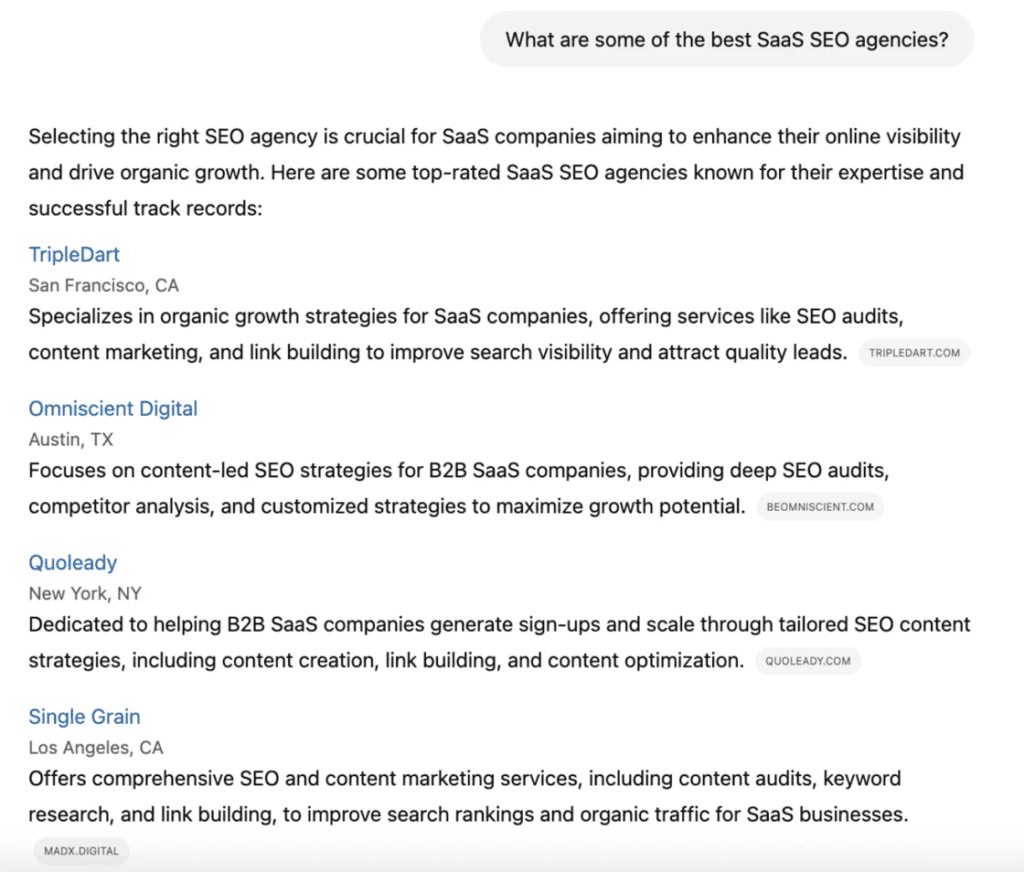
Costly Signaling and the Power of Unpredictability
One fun heuristic I’m playing with is to consider what AI can do well and easily (and is therefore likely to rise in use), and then doing the opposite of that.
In some sense, our powers of irrationality, and specifically, costly signaling, may be the signals that matter the most.
Costly signaling is the idea that certain signals only work because they are expensive, difficult, or irrational in the short term.
Anyone can publish AI-generated blog posts. Few companies invest in a high-quality print magazine. Anyone can run paid ads. Few companies create irreplaceable in-person experiences that deepen brand affinity.
Brand as the Ultimate Signal in a Flooded Market
At the highest level, brand acts as a filtering mechanism. It compresses decision-making for consumers, making it easier to choose amidst overwhelming options.
When content is infinite, recognition and familiarity create shortcuts. People gravitate toward the brands they know, trust, and feel a connection with.
And that’s what makes brand the ultimate moat, possibly even leading to a compounding Matthew Effect in search, social, and now, LLMs. .
The Path Forward
This is a steeper essay than most newsletter issues, possibly a double black diamond for me.
But lest I come across as too abstract and future-focused, I’ll say that a lot of blocking and tackling is not currently being done in a huge amount of organizations. I’m talking about basic telemetry and measurement, ICP research and intelligent strategy design, and accountability towards growth outcomes. I’m talking about consistency in execution and high standards for excellence.
So even disregarding any of the above AI bets or effects, the companies I see winning are the ones that:
- Ground themselves in ICP research and market realities. One of the most persistent failures in content marketing and SEO is a lack of focus. The temptation is always to go broad, to chase volume, to capture every possible search query or audience. But when you go too broad, you dilute differentiation and relevance. HubSpot, once the dominant force in inbound marketing, has struggled in search recently because its content strategy became too expansive—straying beyond its ICP, beyond what its audience needed, and ultimately beyond its core brand authority.
- Move beyond vanity metrics to business impact. Pageviews, bounce rates, and engagement metrics are proxies—they are not outcomes. Too many marketing teams still orient themselves around traditional traffic goals rather than revenue, pipeline growth, and excess share of voice. AI-driven search and discovery platforms are already reducing click-through rates, surfacing answers more efficiently, and reshaping the entire journey. The brands that measure their impact in terms of business outcomes—not just site traffic—will be the ones that sustain long-term growth.
- Saturate distribution across the full customer journey.The way people discover and evaluate brands is changing. AI search models, LLM-powered research tools, shifting social algorithms, and the evolution of classic SERPs mean that discovery is no longer just about ranking on Google. Winning requires omnipresence—a structured effort to ensure that your brand is consistently visible across every touchpoint that matters. This is why Surround Sound SEO, multi-channel content ecosystems, and distribution-led marketing strategies are becoming essential.
- Systematize credibility, data, and brand differentiation. The fundamental shift happening right now is that how you win in marketing is becoming less about tactics and more about structural advantages, like the above mentioned credibility, proprietary data, and brand affinity.
As I’ve stated before, I’m optimistic because now we have real, exciting, and uncertain problems to figure out. There’s a lot of opportunity in volatility and platform disruption for those who lean into it.
Want more insights like this? Subscribe to our Field Notes.
